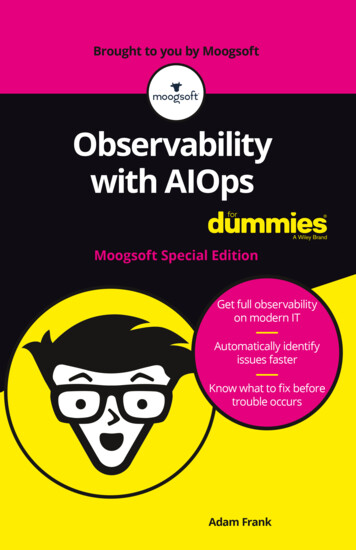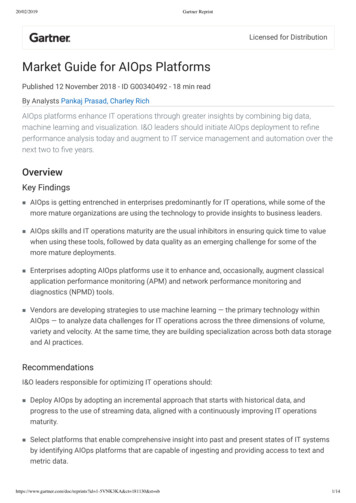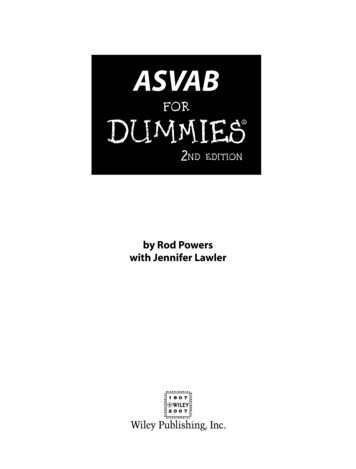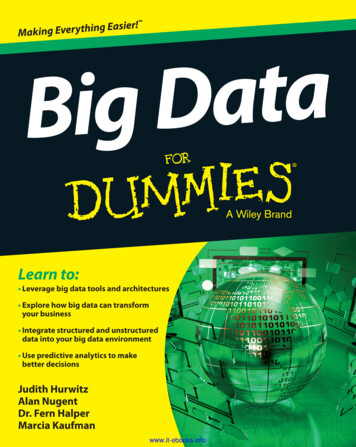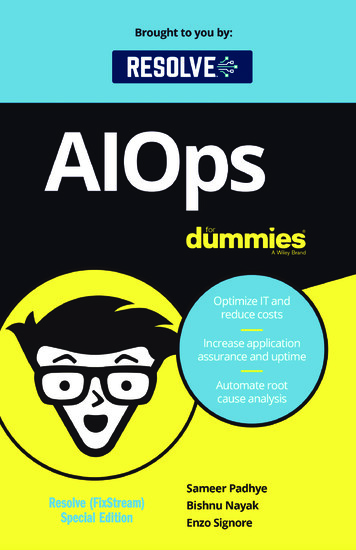
Transcription
About Resolve(recently acquired FixStream)Resolve recently acquired FixStream, adding robust AIOps capabilities to ourautomation ecosystem. Designed to address increasing IT complexity, theplatform includes agentless discovery and automated dependency mapping,advanced event correlation, and predictive analytics that proactively identifyand prevent issues.Combining AI-driven insights with intelligent automations, Resolve offers aclosed-loop of discovery, analysis, detection, prediction, and automation. Ourgoal is to fuel agile, autonomous IT operations with a long-term vision ofdelivering on the promise of “self-healing IT.” Learn more at https://resolve.ioThese materials are 2018 John Wiley & Sons, Inc. Any dissemination, distribution, or unauthorized use is strictly prohibited.
AIOpsResolve (FixStream)Special Editionby Sameer Padhye,Bishnu Nayak andEnzo SignoreThese materials are 2018 John Wiley & Sons, Inc. Any dissemination, distribution, or unauthorized use is strictly prohibited.
AIOps For Dummies , FixStream Special EditionPublished byJohn Wiley & Sons, Inc.111 River St.Hoboken, NJ 07030-5774www.wiley.comCopyright 2018 by John Wiley & Sons, Inc., Hoboken, New JerseyNo part of this publication may be reproduced, stored in a retrieval system or transmitted in anyform or by any means, electronic, mechanical, photocopying, recording, scanning or otherwise,except as permitted under Sections 107 or 108 of the 1976 United States Copyright Act, withoutthe prior written permission of the Publisher. Requests to the Publisher for permission should beaddressed to the Permissions Department, John Wiley & Sons, Inc., 111 River Street, Hoboken, NJ07030, (201) 748-6011, fax (201) 748-6008, or online at http://www.wiley.com/go/permissions.Trademarks: Wiley, For Dummies, the Dummies Man logo, The Dummies Way, Dummies.com,Making Everything Easier, and related trade dress are trademarks or registered trademarks of JohnWiley & Sons, Inc. and/or its affiliates in the United States and other countries, and may not beused without written permission. All other trademarks are the property of their respective owners.John Wiley & Sons, Inc., is not associated with any product or vendor mentioned in this book.LIMIT OF LIABILITY/DISCLAIMER OF WARRANTY: THE PUBLISHER AND THE AUTHOR MAKE NOREPRESENTATIONS OR WARRANTIES WITH RESPECT TO THE ACCURACY OR COMPLETENESS OFTHE CONTENTS OF THIS WORK AND SPECIFICALLY DISCLAIM ALL WARRANTIES, INCLUDINGWITHOUT LIMITATION WARRANTIES OF FITNESS FOR A PARTICULAR PURPOSE. NO WARRANTYMAY BE CREATED OR EXTENDED BY SALES OR PROMOTIONAL MATERIALS. THE ADVICEAND STRATEGIES CONTAINED HEREIN MAY NOT BE SUITABLE FOR EVERY SITUATION. THISWORK IS SOLD WITH THE UNDERSTANDING THAT THE PUBLISHER IS NOT ENGAGED INRENDERING LEGAL, ACCOUNTING, OR OTHER PROFESSIONAL SERVICES. IF PROFESSIONALASSISTANCE IS REQUIRED, THE SERVICES OF A COMPETENT PROFESSIONAL PERSON SHOULD BESOUGHT. NEITHER THE PUBLISHER NOR THE AUTHOR SHALL BE LIABLE FOR DAMAGES ARISINGHEREFROM. THE FACT THAT AN ORGANIZATION OR WEBSITE IS REFERRED TO IN THIS WORKAS A CITATION AND/OR A POTENTIAL SOURCE OF FURTHER INFORMATION DOES NOT MEANTHAT THE AUTHOR OR THE PUBLISHER ENDORSES THE INFORMATION THE ORGANIZATIONOR WEBSITE MAY PROVIDE OR RECOMMENDATIONS IT MAY MAKE. FURTHER, READERSSHOULD BE AWARE THAT INTERNET WEBSITES LISTED IN THIS WORK MAY HAVE CHANGED ORDISAPPEARED BETWEEN WHEN THIS WORK WAS WRITTEN AND WHEN IT IS READ.For general information on our other products and services, or how to create a custom ForDummies book for your business or organization, please contact our Business DevelopmentDepartment in the U.S. at 877-409-4177, contact info@dummies.biz, or visit www.wiley.com/go/custompub. For information about licensing the For Dummies brand for products or services,contact BrandedRights&Licenses@Wiley.com.ISBN 978-1-119-52997-2 (pbk); ISBN 978-1-119-52996-5 (ebk)Manufactured in the United States of America10 9 8 7 6 5 4 3 2 1Publisher’s AcknowledgmentsSome of the people who helped bring this book to market include the following:Project Editor: Elizabeth KuballAcquisitions Editor: Katie MohrProduction Editor:Mohammed Zafar AliEditorial Manager: Rev MengleBusiness DevelopmentRepresentative: Karen HattanThese materials are 2018 John Wiley & Sons, Inc. Any dissemination, distribution, or unauthorized use is strictly prohibited.
IntroductionArtificial intelligence for IT operations (AIOps) is the nextgeneration of IT operations analytics (ITOA). Its value is inhelping organizations address IT challenges on a numberof fronts, including the following:»» The increasing complexity and dynamic nature of ITarchitectures»» Digital business transformation»» Siloed IT operations»» Exponential data growthSo, what’s the difference between AIOps and ITOA?AIOps is a major shift from traditional ITOA platforms. As theprecursor to AIOps evolution, ITOA focuses on data collection and unification for historical data analysis across domainsand resolves problems with observational data. AIOps leveragesbig data and machine learning techniques to deliver proactiveand predictive insights into problems and recommends — and automates — remedial actions. AIOps helps businesses with proactive planning and identification of business-impacting issuesbefore they occur.AIOps solutions can address these challenges. They enable enterprises to unify and modernize IT operations. And they allowenterprises to make the most of their existing infrastructureinvestments.In this book, you learn how AIOps can transform your IToperations.Foolish AssumptionsA wise person once said that most assumptions have outlivedtheir uselessness, but we assume a few things nonetheless!Mainly, we assume that you’re an IT operations professional orenterprise architect responsible for IT infrastructure, applications,Introduction1These materials are 2018 John Wiley & Sons, Inc. Any dissemination, distribution, or unauthorized use is strictly prohibited.
and business processes. As such, this book is written for technical readers with some knowledge of topics such as IT operations,infrastructure, applications, big data, and machine learning.If any of these assumptions describes you, then this book is foryou! If none of these assumptions describes you, keep readinganyway. It’s a great book and when you finish reading it, you’llknow a few things about AIOps!Icons Used in This BookThroughout this book, we occasionally use special icons to callattention to important information. Here’s what to expect:The Remember icon points out information you should committo your nonvolatile memory, your gray matter, or your noggin —along with anniversaries and birthdays!You won’t find a map of the human genome here, but if you seekto attain the seventh level of NERD-vana, perk up! Anythingmarked with the Technical Stuff icon explains the jargon beneaththe jargon!Tips are appreciated, never expected — and we sure hope you’llappreciate these tips. The Tip icon points out useful nuggets ofinformation.These alerts point out the stuff your mother warned you about(well, probably not), but they do offer practical advice to help youavoid potentially costly or frustrating mistakes.Beyond the BookThere’s only so much we can cover in 48 short pages, so if youfind yourself at the end of this book, thinking, “Where can I learnmore?,” just go to www.fixstream.com.2AIOps For Dummies, FixStream Special EditionThese materials are 2018 John Wiley & Sons, Inc. Any dissemination, distribution, or unauthorized use is strictly prohibited.
IN THIS CHAPTER»» Understanding how complexity andfrequent changes limit visibility»» Assessing the cost of downtime in thedigital enterprise»» Missing the big picture because of siloedoperations»» Staying afloat in a deluge of dataChapter1Recognizing ITOperations ChallengesModern IT operations challenges render traditional,domain-centric monitoring and IT operations management systems inadequate. Such systems can’t correlatethe onslaught of data that various IT domains create, and they’reunable to provide the insights that IT operations teams need toproactively manage their environments. In this chapter, you learnhow these challenges impact IT operations.Increasingly Complex andDynamic IT ArchitecturesTo increase business agility, IT organizations are deployingdynamic, modern IT architectures enabled by virtualization technologies. That includes containers, elastic clouds, microservices,and virtual machines. Consider the following:»» According to a September 2017 report by Cloud FoundryFoundation, at least a quarter of businesses had adoptedcontainers by late 2017.CHAPTER 1 Recognizing IT Operations Challenges3These materials are 2018 John Wiley & Sons, Inc. Any dissemination, distribution, or unauthorized use is strictly prohibited.
»» 451 Research’s “Cloud-Enabling Technologies MarketMonitor” report found that the application container marketwas worth 762 million in 2016 and is expected to balloon to 2.7 billion by 2022.»» The use of cloud platforms is also on the rise, as morebusinesses migrate more applications to the cloud. A recentIntel Security report predicted that 80 percent of all ITbudgets would be committed to cloud solutions by July 2018.The agility these architectures and technologies enable is important for businesses. It helps them adjust to the fluctuatingdemands of millions of digital customers around the globe.However, that often comes at the cost of decreased visibility. That’sbecause application workloads and flows are now abstracted fromtheir physical infrastructure. And that creates new challenges inpinpointing potential issues.Without end-to-end correlated data, adoption of these key technologies can be risky and cumbersome. IT staff will be unable toeffectively map current workloads to these new environments,and they’ll struggle to manage their performance and uptime.Digital Business TransformationEnterprises across the globe are leveraging digital technology totransform their businesses. Such efforts aim to provide betterexperiences to their prospects, customers, suppliers, and internalstakeholders.To succeed as digital companies, businesses need to rethink theirentire IT stack and operational strategy. And they need to groundthese efforts with business-first considerations.That should include how they think about application and infrastructure uptime as well.A recent study by Digital Enterprise Journal (DEJ) found that enterprises incur an average cost of 300,000 per outage. That’s if norevenue is at stake. If the outage impacts revenues, organizations4AIOps For Dummies, FixStream Special EditionThese materials are 2018 John Wiley & Sons, Inc. Any dissemination, distribution, or unauthorized use is strictly prohibited.
lose an average of 72,000 per minute. That means companieslose a whopping 5.6 million per outage!Modern enterprises that don’t make application assurance anduptime a top objective could face catastrophic damage to theirrevenues and reputation.Siloed IT OperationsResearch by DEJ suggests that 41 percent of enterprises use ten ormore tools for IT performance monitoring; 70 percent use morethan six. And you need even more tools to manage a hybrid cloudenvironment, including solutions to monitor workloads runningin Amazon Web Services (AWS), Microsoft Azure, and multi-cloudenvironments.Domain-centric tools provide a deep view into a specific domain,but they lack the ability to provide a correlated, end-to-end viewacross domains (see Figure 1-1).FIGURE 1-1: IT operational silos limit business velocity.That’s a problem because cross-domain data collection, correlation, and visibility are key. They can enable you to track transaction problems like failed e-commerce orders to infrastructureissues like a network problem, for example.But siloed management tools prevent most organizations frommaking these important connections. As a result, most enterprises suffer longer mean time to repair (MTTR) leading tounhappy customers. Additionally, CIOs and heads of IT operationscan’t respond to business needs timely and proactively.CHAPTER 1 Recognizing IT Operations Challenges5These materials are 2018 John Wiley & Sons, Inc. Any dissemination, distribution, or unauthorized use is strictly prohibited.
According to DEJ, MTTR averages 4.2 hours and wastes preciousresources. Businesses employ an average of 5.8 full-time equivalent (FTE) employees to address each incident. In 15 percent ofcases, that FTE figure is as high as 11.The drain on human resources and finger pointing occurs as ITteam members struggle to manually correlate data — often lotsof data. Solving a critical business problem often entails usingthousands of data points. Imagine how complex it becomes whenIT must analyze thousands or millions of data points.Exponential Uncorrelated Data GrowthIndeed, millions of data points are now flowing to the IT operations team in real time. This data deluge will only accelerate asadoption of containers, microservices, and virtualization grows.According to DEJ, in the last 12 months, enterprises collected88 percent more data than the prior year. Containers alone generate 18 times more data than traditional IT environments.There are automated ways to collect and process this massiveamount of data from an individual domain, but domain-specificteams then need to manually correlate it — and 79 percent oforganizations report that adding more IT staff to address thisproblem is not an effective strategy, according to DEJ. This is notonly time consuming but also prone to incorrect interpretationand results, requiring skilled resources from different domains,thus leading to a very long diagnostic process for root causeidentification.To address these challenges, organizations need a new class oftechnology to modernize the IT operations process with powerfulcorrelation, analytics, and visualization capabilities. This technology needs to be able to»» Correlate millions of data points across all IT domains.»» Analyze data to detect patterns using machine learning.»» Visualize information so that organizations can easily seewhat’s happening and gain powerful insights.IT organizations need AIOps.6AIOps For Dummies, FixStream Special EditionThese materials are 2018 John Wiley & Sons, Inc. Any dissemination, distribution, or unauthorized use is strictly prohibited.
IN THIS CHAPTER»» Defining AIOps»» Delivering business value with AIOps»» Deconstructing the building blocks of anAIOps architectureChapter2Modernizing ITOperations withArtificial IntelligenceIn this chapter, you learn all about AIOps: what it is, how itdelivers value, and how it works.AIOps DefinedGartner recognizes AIOps as a new strategic IT segment (seeFigure 2-1):Artificial intelligence for IT operations (AIOps) platforms aresoftware systems that combine big data and AI [artificialintelligence] and machine learning functionality to enhanceand partially replace a broad range of IT operations processesand tasks, including availability and performance monitoring,event correlation and analysis, IT service management, andautomation.CHAPTER 2 Modernizing IT Operations with Artificial Intelligence7These materials are 2018 John Wiley & Sons, Inc. Any dissemination, distribution, or unauthorized use is strictly prohibited.
Source: Garner, March 2016FIGURE 2-1: Gartner’s visualization of the AIOps platform.The general process by which AIOps platforms and solutionsoperate includes three basic steps: observe, engage, and act.ObserveAn AIOps platform first needs to observe the nature of data andits behavior. That involves collecting information through datadiscovery.AIOps data discovery needs to support big data scale. That way,it can address the volume of data from different IT domains andsources. Those sources may include legacy infrastructure or newcontainer, hybrid cloud, or virtualized environment elements.Whatever the data or source, speed is key to the observation partof the process. So, the data must be collected in near real timeto detect patterns. Performance- and health-related informationis collected from hundreds of sources — using an agentless oragent-based model. Successful AIOps platforms leverage a combination of mechanisms to collect data from a multi-domain andmulti-vendor environment. That environment may include anarray of containers, hypervisors, network and storage solutions,public cloud, and other technologies and architectures.8AIOps For Dummies, FixStream Special EditionThese materials are 2018 John Wiley & Sons, Inc. Any dissemination, distribution, or unauthorized use is strictly prohibited.
A successful AIOps platform also combines the power of big dataand machine learning with domain knowledge to identify datarelationships and history to solve this complex problem.EngageAn AIOps platform provides orchestration across key IT operations domains — most important, IT service management (ITSM).ITSM activities, such as asset management, change management, and incident management, have traditionally been manual,and they’re typically heavily dependent upon the configurationmanagement database (CMDB). The problem with legacy CMDBsis that they’re highly unreliable for environments involving frequent change.The AIOps platform provides analytics and input to make ITSMtasks more automated and reliable. For example, AIOps canupdate CMDBs using its knowledge of the environment, state, andchanges. The AIOps platform’s ability to observe hybrid environments on an end-to-end basis provides this power. This ensuresCMDB data is relevant and reliable and allows for automation andfaster and more accurate incident management. The automationalso minimizes risks that might otherwise happen due to humanerror. Finally, pattern recognition allows businesses to see andaddress problems before they affect the end-user experience.Data discovery in the AIOps platform is done using an algorithmic approach. A successful discovery is accomplished by combining domain knowledge of the IT environment with efficient dataprocessing algorithms to process data observed from entities inmulti-vendor and multi-domain environments. The discoveryalgorithm should have the capabilities to discover meaningfuldata from infrastructure and application entities supporting critical business functions — for example service information, configuration data, relationship information across domains includingtopology data, hierarchical relationships between entities, andmore (for example, virtual machine to hypervisor relationships).ActAutomation or closed loop functions is the nirvana of AIOpsplatform.CHAPTER 2 Modernizing IT Operations with Artificial Intelligence9These materials are 2018 John Wiley & Sons, Inc. Any dissemination, distribution, or unauthorized use is strictly prohibited.
Of course, automating critical IT operations using machine learning is new territory for most organizations, and IT leadership willneed to get comfortable with it before they fully embrace automation. But new state-of-the-art automation — which usesadvanced human inputs and machine learning — is maturing,and organizations can employ it today to do both simple and morecomplex jobs.For example, they can employ automation to clean log files to freeup space, and they can use it to restart an application. Automation also can change application traffic policy on a router if AIOpssees the need.How and Where AIOps Delivers ValueEnterprises that have deployed AIOps solutions have experiencedtransformational benefits. They include revenue growth, bettercustomer retention, improved customer experience, lower costs,and enhanced performance.Their operational teams have been able to:»» Increase end-to-end business application assurance anduptime. Manage an integrated set of business and operationalmetrics. Predict and prevent outages. Lower the number of IT full-time equivalents (FTEs)dedicated to troubleshooting. Decrease operational noise and alerts.Dramatically reduce mean-time-to-detect (MTTD) andmean-time-to-repair (MTTR).»» Optimize IT and reduce IT costs. Replace older, silo-focused IT monitoring tools. Auto-discover complex, heterogeneous topologies. Gain visibility into the hybrid IT environment. Accelerate migration to the hybrid cloud.10AIOps For Dummies, FixStream Special EditionThese materials are 2018 John Wiley & Sons, Inc. Any dissemination, distribution, or unauthorized use is strictly prohibited.
Expedite the adoption of hyper-convergence andmicroservices architecture. Reduce risk in consolidating and migrating data centers.»» Free up resources to enable IT operations to become aproactive source of innovation. Automate and reduce the cost of audits and compliance.Simplify IT processes.Break down silos across their IT teams.Enable less experienced staff to become more productive, faster.What the AIOps Architecture Looks LikeAn AIOps solution includes the following functional blocks (seeFigure 2-2):»» Open data ingestion: An AIOps platform collects data of alltypes from various sources. This may include operationalinsights such as faults, logs, performance metrics, log alerts,tickets, and more. The ability to ingest data from the mostdiverse data sources is critical because it allows for anaccurate, real-time view of all the moving parts across hybridIT environments.»» Auto-discovery: Given the very dynamic nature of modernIT environments, businesses need an auto-discovery processthat automatically collects data across all infrastructure andapplication domains — including on-premises, virtualized,and cloud deployments. Auto-discovery also identifies allinfrastructure devices, the running applications, and theresulting business transactions.»» Correlation: Next, the AIOps platform correlates this data ina contextual form. It needs to determine the relationshipsbetween infrastructure elements, between an applicationand its infrastructure, and between the business transactions and the applications.CHAPTER 2 Modernizing IT Operations with Artificial Intelligence11These materials are 2018 John Wiley & Sons, Inc. Any dissemination, distribution, or unauthorized use is strictly prohibited.
»» Visualization: When the end-to-end correlation process iscompleted, data need to be presented in an easy-to-useformat. And that’s what visualization is all about.Visualization is important because it allows IT operations toquickly pinpoint issues and take corrective actions. Everysolution includes a dashboard of some type. Yet an estimated 71 percent of organizations say data is not actionable.That’s why AIOps is important. It provides a new generationof visualization that makes data actionable.»» Machine learning: Finding the root cause of a problem iskey. But it’s even more critical to determine recurringpatterns and predict likely future events. AIOps solutions usesupervised and unsupervised machine learning to determinepatterns of events in a time series. They also detect anomalies from expected behaviors and thresholds and predictoutages and performance issues.»» Automation: Automation is a key component of AIOpsbecause it delivers the end return on investment (ROI) to thecustomer. It does so by automating human IT operationstasks, reducing significant operating expenses (OPEX), andexpediting innovation. It also reduces MTTR and can improvecustomer satisfaction.AIOps enables IT operations to modernize existing processes.It allows IT operations to make progress versus traditional IToperations analytics (ITOA) strategies, abandon old, reactive processes, and become proactive by predicting issues and preventingoutages.FIGURE 2-2: The building blocks of an AIOps architecture.12AIOps For Dummies, FixStream Special EditionThese materials are 2018 John Wiley & Sons, Inc. Any dissemination, distribution, or unauthorized use is strictly prohibited.
IN THIS CHAPTER»» Getting a complete picture of yourinfrastructure»» Ensuring application uptime andperformance»» Going beyond infrastructure andapplication discovery and insightsChapter3Understanding AIOpsCapabilitiesIn this chapter, you learn about current infrastructure andapplication discovery and insight challenges, and how AIOpscapabilities address these challenges.Infrastructure Discovery and InsightsWe live in a world that is massively distributed, disparate, anddiverse.In different cultures, there are many different people speakingmany different languages. If you can interact with these individuals in their language, you can learn a lot, and the broaderknowledge and insights can significantly benefit people, as wellas businesses, around the world.Enterprise networks are worlds of their own, and in some ways,they mirror this larger disparate world.CHAPTER 3 Understanding AIOps Capabilities13These materials are 2018 John Wiley & Sons, Inc. Any dissemination, distribution, or unauthorized use is strictly prohibited.
Enterprise hybrid IT data centers contain lots of entities acrossnetwork, compute, and storage supplied by different technologyvendors. The vendors that supply these technologies have theirown cultures, syntaxes, and languages to manage and interactwith other entities in the IT environment.But if you can interact with these distributed entities in a normalized way and understand how they relate to one another, you canderive a deeper understanding into the end-to-end environment.That understanding helps enterprises manage their IT environments optimally and profitably.The point is that we live in a diverse world, and when we collectinformation about different entities around the world from different sources, we gain greater understanding. An AIOps platformhelps businesses improve their IT operations by understandingtheir application and IT infrastructure resources.AIOps technology can»» Collect data from disparate IT entities and siloed systems»» Correlate and analyze the flood of data from differentsources»» Present that information in a way that makes it quick andeasy for businesses to understand and gain value from itBut before data is correlated and visualized, it needs to be collected from millions of disparate data sources. One of the keychallenges IT organizations face is the complexity associated withdiscovering disparate entities in a hybrid IT environment. Environments are quickly changing as digital service deploymentsadopt newer technologies such as virtualization, hybrid cloud,containers, microservices, and more.The traditional discovery tools and mechanisms provided by legacy IT operations analytics (ITOA) vendors lack the agility, reliability, and completeness in keeping up with the changes thattake place across a multi-vendor, multi-domain, and multitechnology environment.14AIOps For Dummies, FixStream Special EditionThese materials are 2018 John Wiley & Sons, Inc. Any dissemination, distribution, or unauthorized use is strictly prohibited.
Auto-discovery is becoming a fundamental requirement fortoday’s IT operations because troubleshooting, capacity planning,maintenance, and effective management are dependent on it.Auto-discovery in this context describes the process of automatically fetching lots of data from many disparate sources. AIOpscan do this because it knows how to communicate with the various infrastructure and application entities. Data is collected bydata collectors from all kinds of entities — switches, routers, loadbalancers, firewalls, servers, storage devices, hypervisors, virtualmachines, application entities, and more — whether physical,virtual, or logical.Beyond auto-discovery, AIOps identifies the relationships betweenall the entities in a hybrid IT environment and quickly identifiesthe root cause of complex business-impacting issues. AIOps autodiscovery feeds discovered entities and relationships to ITSMtools to further enrich the value of the ITSM capabilities, whichoptimizes business processes and reduces operational cost andoverhead.AN AUTO-DISCOVERY USE CASEBroadcom, a global semiconductor company, deployed the FixStreamAIOps platform to reduce MTTR, increase visibility, and gain newinsights across its worldwide data centers.ChallengeLimited visibility of hybrid IT infrastructure and automatic discoveryconfiguration item (CI) relationships: There is a lack of dynamic and complete IT infrastructure inventoryinformation. Manual tracking and update of relationships between CIs inServiceNow configuration management database (CMDB) istime-consuming and becomes quickly outdated. Issues with IP address and CI parameter duplication are difficult todetect and resolve due to lack of visibility. There is a lack of automated correlation of application serviceswith infrastructure entities.(continued)CHAPTER 3 Understanding AIOps Capabilities15These materials are 2018 John Wiley & Sons, Inc. Any dissemination, distribution, or unauthorized use is strictly prohibited.
(continued)SolutionFixStream’s agentless auto-discovery enables Discovery of tens of thousands of devices in real time Automatic and dynamic updates of CI relationships across entitiesin ServiceNow CMDB Quick detection of IP and CI parameter duplications in data centers by device type and IP address Discovery of application services correlated with infrastructureenable efficient migration and IT optimization.Visibility into data center infrastructure entities and their relationships with its real-time update to changesResultsOut-of-the-box CI relationship discovery and CMDB update delivers Reduction of IT costs via resource optimization More efficient IT auditing and compliance with the use of relationship mapping Better clarity into infrastructure landscapes and their relationshipsfor faster ticket verification and root-cause analysis Dynamic topology maps for all global data centers with real-timeupdatesMore powerful ServiceNow IT service management capabilitieswith automated out-of-the-box CI relationship ingestionITOA solutions and do
advanced event correlation, and predictive analytics that proactively identify and prevent issues. Combining AI-driven insights with intelligent automations, Resolve offers a closed-loop of discovery, analysis, detection, prediction, and automation. Our goal is to fuel a
